Győr
| Győr | |||
|---|---|---|---|
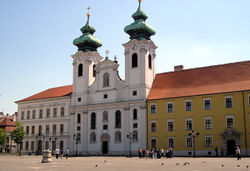 |
|||
|
|||
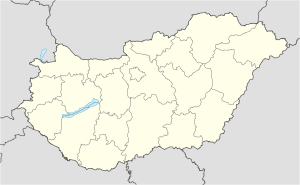 Győr
|
|||
| Coordinates: | |||
| Country | |||
| County | Győr-Moson-Sopron | ||
| Government | |||
| - Mayor | Zsolt Borkai | ||
| Area | |||
| - Total | 174.61 km2 (67.4 sq mi) | ||
| Population (2010) | |||
| - Total | 130,478 |
||
| - Density | 730.71/km2 (1,892.5/sq mi) | ||
| Time zone | CET (UTC+1) | ||
| - Summer (DST) | CEST (UTC+2) | ||
| Postal code | 9000 - 9030 | ||
| Area code(s) | 96 | ||
Győr (Hungarian pronunciation: [ˈɟøːr] (![]() listen); German: Raab, names in other languages) is the most important city of northwest Hungary, the capital of Győr-Moson-Sopron county, and — halfway between Budapest and Vienna — lies on one of the important roads of Central Europe. The city is the sixth largest in Hungary, and one of the seven main regional centres of the country.
listen); German: Raab, names in other languages) is the most important city of northwest Hungary, the capital of Győr-Moson-Sopron county, and — halfway between Budapest and Vienna — lies on one of the important roads of Central Europe. The city is the sixth largest in Hungary, and one of the seven main regional centres of the country.
Contents |
History
The area has been inhabited since ancient times. The first large settlement dates back to the 5th century BCE; the inhabitants were Celts. They called the town Arrabona, a name that was used for eight centuries and whose shortened form is still used as the German (Raab) and Slovak (Ráb) names of the city.
Roman merchants moved to Arrabona during the 1st century BCE, and around 10 CE the Roman army occupied the northern part of Western Hungary, which they called Pannonia. Although the Roman Empire abandoned the area in the 4th century due to constant attacks by the tribes living to the east, the town remained inhabited.
Around 500 the territory was settled by Slavs, in 547 by the Lombards, in 568-c.800 by the Avars, at that time under Frankish and Slavic influence, then between 880 and 894 it was part of Great Moravia, and then briefly under East Frankish dominance.
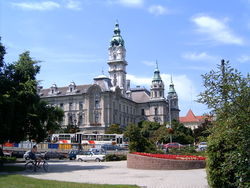
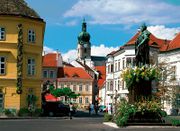
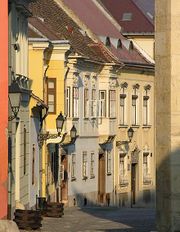
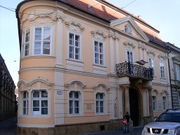
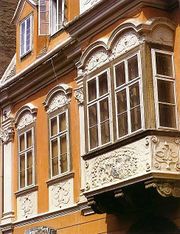

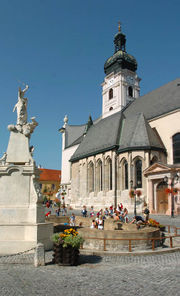
The Magyars occupied the town around 900 and fortified the abandoned Roman fortress. Stephen I, the first king of Hungary, founded an episcopate there. The town received its Hungarian name Győr. The Hungarians lived in tents, later in cottages, in what is now the southeastern part of the city centre. The town was affected by all the trials and tribulations of the history of Hungary: it was occupied by Mongols during the Mongol invasion of Hungary (1241–1242) and then was destroyed by the Czech army in 1271.
After the disastrous battle of Mohács, Baron Tamás Nádasdy and Count György Cseszneky occupied the town for King Ferdinand I while John Zápolya also was attempting to annex it. During the Ottoman occupation of present-day central and eastern Hungary[1] (1541 - late 17th century), Győr's commander Kristóf Lamberg thought it would be futile to try to defend the town from the Turkish army, and he burnt the whole town instead; the Turkish found nothing but blackened ruins, hence the Turkish name for Győr, Yanık kale ("burnt city").
The town was rebuilt and surrounded with a castle and a city wall, designed by the leading Italian builders of the era. The town changed a lot during these years, with lots of new buildings built in Renaissance style, but the main square and the grid of streets remained.
In 1594, after the death of Count János Cseszneky, captain of Hungarian foot-soldiers, the Turkish army occupied the castle and the town, but in 1598 the Hungarian and Austrian army managed to occupy it again.
In 1683, Turks returned briefly, only to leave again after being defeated in the Battle of Vienna.
The town became prosperous during the following centuries. In 1743 Győr was elevated to free royal town status by Maria Theresa. Many religious orders (Jesuits, Carmelites) settled in the town and they built schools, churches, a hospital and a monastery.
Napoleon occupied the castle and had some of its walls blown up. The leaders of the town soon realized that the old ramparts weren't useful any more. Most of the ramparts were destroyed and thus the town could expand.
In mid-1800s, Győr's role in trade grew as steamship traffic on the River Danube began, but the town lost its importance in trade when the railway line between Budapest and Kanizsa was built in 1861. The town leaders compensated for this loss with industrialisation. The town prospered till World War II, but during the war several buildings were destroyed.
The Jewish population (12.6% of the town according to the 1910 census) were ordered to move to the ghetto on May 13, 1944. Two trains carried the Jews of the town and the neighboring villages to Auschwitz on June 11 and on June 14. Altogether, 5,635 people were deported on these two days. Some exempted Jews were left behind, but they were massacred on March 26, 1945, just hours before liberation.
The 1950s and 60s brought more change: only big blocks of flats were built, and the old historical buildings weren't given care or attention. In the 1970s the reconstruction of the city centre began; old buildings were restored and reconstructed. In 1989 Győr won the European award for the protection of monuments.
Győr has an enchanting centre and beautiful Baroque buildings. The ancient core of the city is Káptalan Hill at the confluence of three rivers: the Danube, Rába, and Rábca. Püspökvár, the residence of Győr’s bishops (5/A Káptalan Hill), can be easily recognised by its incomplete tower. Győr’s oldest buildings are the 13th-century dwelling tower and the 15th-century Gothic Dóczy Chapel. The Bishop’s Cathedral ranks as a ‘basilica minor’ (Apor Vilmos püspök Square).
Today Győr is one of the most important administrative and cultural centres of Hungary . The city is also a university town and a popular tourist destination.
A 100-year-old Raba factory on the River Danube close to the historical centre is to be replaced by a new master-planned community called Városrét. The mixed-use community will have residential and commercial space as well as schools, clinics and parks.
The city's main theatre is the National Theatre of Győr, finished in 1978, featuring large ceramic ornaments made by Victor Vasarely.
Tourist sights
- Historical centre
- Cathedral (originally Romanesque; rebuilt in Gothic and Baroque style)
- City Hall
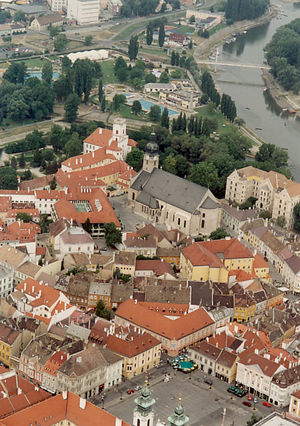
Industry
- Audi AG subsidiary company Audi Hungaria Motor Kft. has a big factory in Győr, where the Audi TT sports car, the A3 Cabriolet,[2] and many engines (1,913,053 engines in 2007) are built. The factory opened in 1994, at first producing inline-four engines for the Audi marque. Business then spread to assembling the Audi TT Coupé and TT Roadster. Eventually, V6 and V8 engines were also included, and after the acquisition of Automobili Lamborghini S.p.A., Audi then began to build V10 engines. The V10s for Audi vehicles are fully assembled here, but only the cylinder blocks for the Lamborghini V10.[3] Engines are also supplied to other Volkswagen Group marques, but over 90% of Audi vehicle engines are made here.[4]
Notable people
- Johann Georg Albrechtsberger, composer
- Tamás Bakócz, archbishop
- Miklós Borsos, sculptor
- Gergely Czuczor
- Josef Dobrovský
- Anita Görbicz, handball player
- Izidor Guzmics
- Stanley Jaki
- Ányos Jedlik
- Josip Jelačić
- Gyula König
- Margit Kovács
- Sándor Liezen-Mayer, painter
- Raimondo Montecuccoli
- Desiderius Orban, painter
- Antal Pusztai
- Alexander Raab, pianist
- Frigyes Riesz, mathematician
- Marcel Riesz, mathematician
- Samuel Aba of Hungary, king
- Ľudovít Štúr
- József Szlávy, prime minister of Hungary
- Mathias Unger senior and junior, playing-card makers
- Alois/Alajos Unger, painter
- Tibor Varga
- Emil Zuckerkandl
- Andrew Ivanyi
- Zoli Pitman
Sports
Győr is the home of the well known Győri ETO Sport Club which has many sport divisions. The most popular sport in the city is handball. The Győri ETO KC is the number one team in women's handball in Hungary. Győri ETO FC has an illustrious history in Hungarian football.
Gallery
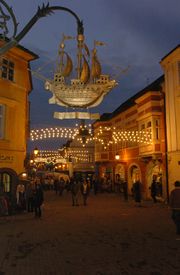 |
 Castlewall |
 City centre |
 |
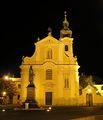 White Friar Church |
 |
 Marian Culums |
 Ladislaus I of Hungary |
100.jpg) |
 |
 |
 |
International relations
Twin towns — sister cities
Győr is twinned with:
References
Notes
- ↑ http://www.britannica.com/EBchecked/topic/511433/Royal-Hungary
- ↑ "Start of production and world premiere for the Audi A3 Cabriolet in Hungary". Volkswagen AG. 30 November 2007. http://www.volkswagenag.com/vwag/vwcorp/info_center/en/news/2007/11/Produktionsstart.html. Retrieved 30 August 2009.
- ↑ "Lamborghini Cars full specifications - First spyshots of the Lamborghini L140 model". LamboCars.com. http://www.lambocars.com/archive/newl140.htm. Retrieved 30 August 2009.
- ↑ Audi ups Hungarian output BBJ.hu
- ↑ "Официальный сайт города Брянска" (in Russian). Admin.bryansk.ru. http://admin.bryansk.ru/international/partners.html. Retrieved 2009-07-08.
External links
- Official site (Hungarian) (English) (German)
- Info-Győr.com , Győr's high-class information portal
- Győr travel guide from Wikitravel
- Gyor-online.hu A portal site (Hungarian)
- Aerial photography: Győr
- Aerial view of Gyor by Volkan Yuksel
|
|||||||||||||||||
|
||||||||||
|
||||||||||||||||||||


